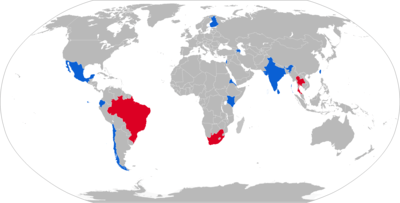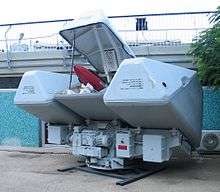Gabriel (missile)
Gabriel missiles, created by Israel Aerospace Industries, are a range of anti-ship missiles that use the technique of sea skimming, created in response to an attack on an Israeli warship in 1967. The Mark IV version was in service with the Israeli Navy while other versions are in service with navies around the world.
| Gabriel | |
|---|---|
 An IAI Gabriel Anti-ship missile | |
| Type | Anti-ship missile |
| Place of origin | Israel |
| Service history | |
| In service | 1962 |
| Used by | See operators |
| Production history | |
| Manufacturer | Israel Aerospace Industries |
| Variants | developed from Luz (missile) |
| Specifications | |
| Mass | Mark I: 430 kg (950 lb) Mark II: 522 kg (1,151 lb) Mark III: 560 kg (1,230 lb) Mark III A/S: 590 kg (1,300 lb) Mark IV: 960 kg (2,120 lb) |
| Length | Mark I: 3.35 m (11.0 ft) Mark II: 3.36 m (11.0 ft) Mark III: 3.75 m (12.3 ft) Mark III A/S: 3.78 m (12.4 ft) Mark IV: 4.7 m (15 ft) |
| Diameter | Mark I/ II /III / IIIA/S: 330 mm (13 in) Mark IV: 440 mm (17 in) |
| Warhead | Mark II: 100 kg (220 lb) Mark III / IIIA/S: 150 kg (330 lb) Mark IV: 240 kg (530 lb) |
| Wingspan | Mark I / II:1.35 m (4 ft 5 in) Mark III:1.32 m (4 ft 4 in) Mark IIIA/S1.08 m (3 ft 7 in) Mark IV:1.60 m (5 ft 3 in) |
Operational range | Mark I: 20 km (12 mi) Mark II:6–36 km (3.7–22.4 mi) Mark III:36 km (22 mi) Mark IIIA/S:60 km (37 mi) Mark IV:200 km (120 mi) |
| Flight altitude | 2.5 m (8 ft 2 in) |
Guidance system | Mark I / II:Semi-Active Radar Mark III / IIIA/S / IV: Active Radar |
Origin
On October 21, 1967, four Styx missiles sank the destroyer INS Eilat, which was patrolling along the northern shores of the Sinai. Forty-seven Israeli sailors and officers were killed or went missing in action and 100 were injured.[1] The loss of the ship prompted the Israeli navy to ask Israel Aerospace Industries to accelerate the development of an anti-ship missile, which had begun in 1958 with the Luz (or Lutz) program.
Development
Faced with Rafael Advanced Defense Systems's anxiety to develop a new guidance system, Shlomo Erell asked Israel Aerospace Industries to take over the program by recruiting Ori Even-Tov, a former Rafael engineer. Even-Tov suggested dropping the guidance joystick approach used by the Luz, and instead proposed the development of an autonomous guidance system which would allow the missile to seek its objective, even in bad weather or bad visibility.[2] He further proposed using an altimeter, allowing the missile to fly some meters over the surface of the sea, making it difficult to detect and allowing it to hit the target just above the waterline. A radar installed on the ship had to guide the missile, while the altimeter would keep the missile in sea-skimming mode.[2]
Gabriel Mk 1
The development of the Gabriel for the Israeli Navy began in 1962,[3] before being first shown to the public in 1970. It was touted to be the world's first operational sea-skimming missile, and saw extensive action during the Yom Kippur War.[4] A batch of 50 was imported by the Republic of China Navy for evaluation and as the interim weapon for the three Allen M. Sumner class destroyers upgraded with Gabriel Mk 2 missile system, and it is also the basis for the Taiwanese Hsiung Feng I missile.
Gabriel Mk 2
The Gabriel Mk 2, an improved version of Gabriel, was created in 1972 and entered service in 1976. It was also built under license South Africa under the name Skerpioen (Afrikaans for Scorpion).[5] The Taiwanese Hsiung Feng I missile can be considered as a parallel development, being based on Gabriel Mk 1 but with similar improvements, and ordnances used by the two systems are interchangeable.
Gabriel III
Gabriel III and Gabriel III A/S were introduced in 1978[6] with major improvements. The air-launched Gabriel III A/S has a range of over 60 km.[7] Both Gabriel III versions employ the widely used 'fire and forget' mode.
Gabriel IV
Developed in the early 1990s is related to the Gabriel Mk III but larger and with a turbojet engine for sustained flight. It is distinguishable from the Mk III because of its swept wings with cropped tip. Like the Mk III, it has 3 guidance modes: Fire and Forget, Fire and Update with data link, and Fire and command using Radar update[4]
Gabriel V (Advanced Naval Attack Missile)
Israel Aerospace Industries is reportedly working on a Gabriel V Advanced Naval Attack Missile, with an advanced active multi-spectra seeker designed for cluttered littoral environments.[8][9]
Older models
Older models of the Gabriel are still used by Chile: Sa'ar 4 with Gabriel II, Israel: Sa'ar 4.5 with Gabriel II, Mexico: Sa'ar 4.5 with Gabriel II, Sri Lanka: Sa'ar 4 with Gabriel II, Thailand: FPB-45 with Gabriel I.
Operational history
During the Yom Kippur War the Gabriel I was used for the first time during the Battle of Latakia. Israeli missile boats armed with Gabriel Mk 1 missiles were credited with defeating Syrian ships armed with the Soviet-made Styx missile. Even though the Styx missile had a longer range, the Gabriel's reliability and flexibility of handling contributed to the Israeli victory. It is known that the Syrians shot missile salvos at the charging Israeli vessels, but missed due to the Israeli ECM technology of the time. When they were in range, the Israeli boats launched their Gabriel missiles, and sank all but one Syrian Osa class ship, which was later sunk by cannon fire. After defeating the Syrian Navy (surviving Syrian ships stayed in port) the Israeli missile boats defeated the Egyptian navy as well, achieving naval supremacy for the remainder of the war.[10][2]
Details
During the Yom Kippur War in 1973, the Styx was shown to be far less effective than previously believed. From October 6 to October 12, 54 missiles were fired to no effect, according to Western sources. The aforementioned Russian sources however, claim that a total of seven ships were sunk - all small vessels such as trawlers, patrol boats, and missile boats. But the Russian specialists agreed with their Western counterparts that the overall results were unsatisfying, especially considering that seven Egyptian and Syrian vessels were sunk after being hit by Israeli Gabriel Mk.1 anti-ship missiles. This last figure is commonly recognized by specialists in both the West and East.
The first such encounter took place during the night of October 6 to October 7, 1973, near Latakia on the Syrian coast. Israeli forces used helicopters flying slowly at very low altitude, effectively simulating naval targets. No Israeli ship was hit by the large salvo of P-15s subsequently fired by the Syrians, who themselves lost the T-43 class trawler Jarmuk and three torpedo boats to Israeli Gabriel missiles. The Syrian missile boats withdrew successfully, but all of their missiles missed the Israeli helicopters, which had climbed to break the missile radars' locks. On the same night, a similar trick with helicopters was repeated against Egyptian ships north of the Sinai Peninsula. Yet another encounter took place near Latakia on the night of October 10–11. This time, the missile exchange between Israeli and Syrian missile boats took place without the use of helicopters, and Israeli ships relied on chaff. The Syrian vessels maneuvered outside their harbor among the anchored merchant ships. Two of the warships were sunk by Gabriel missiles, which also hit two neutral ships, the Greek Tsimentaros and the Japanese Yamashuro Maru. According to Israeli sources, the use of chaff saved all of its vessels. The following night, the helicopter maneuver was again successfully used during an encounter near Tartus off the Syrian coast. No Israeli ship was hit by a salvo of P-15s fired by Syrian missile boats. On the Syrian side, two Komar-class vessels were sunk by Gabriel missiles, and also the Soviet merchant ship Ilya Mechnikov was hit. On the same night, a similar encounter took place off the coast of Port Said.
Operators


Current operators
- Azerbaijan Navy
- Ecuadoran Navy
- Finnish Navy from 2019 onwards[12] (Mk.5[13])
- Kenyan Navy
- Sri Lankan Navy
Former operators
- Republic of China Navy (Mk 2, reduced to reserve status due to service entry of the similar Hsiung Feng I missile and decommissioned in early 1990s)
References
| Wikimedia Commons has media related to Gabriel missile. |
- Cécile Pilverdier. "Histoire d'Israël : année 1967 - Un écho d'Israël". Un-echo-israel.net. Archived from the original on 2011-10-23. Retrieved 2011-11-16.
- Rebinovich, Abraham (December 24, 2011). "Escape from Cherbourg". Jerusalem Post. Archived from the original on October 18, 2012. Retrieved November 1, 2011.
- "Israel Aerospace Industries LTD". Archived from the original on 3 March 2016. Retrieved 8 October 2015.
- Archived 2012-06-29 at the Wayback Machine "Gabriel Family"
- "Defense & Security Intelligence & Analysis: IHS Jane's - IHS". Archived from the original on 11 August 2011. Retrieved 8 October 2015.
- "Gabriel (Israel) - Jane's Air-Launched Weapons". Articles.janes.com. 2010-09-08. Archived from the original on 2011-08-11. Retrieved 2011-11-16.
- John Pike. "Gabriel III". Globalsecurity.org. Archived from the original on 2011-12-30. Retrieved 2011-11-16.
- "Israel Aerospace Industries LTD". Archived from the original on 3 March 2016. Retrieved 8 October 2015.
- "IAI Introduces Gabriel 5 Anti-Ship Missile System". Archived from the original on 24 July 2015. Retrieved 8 October 2015.
- Razoux, Pierre (October–November 2006). "La marine israélienne d'hier à aujourd'hui". Marines et Forces navales (in French) (105).
- Sputnik (27 March 2012). "Azerbaijan Spent $1.6 Bln on Israeli Arms in 2011". Archived from the original on 8 October 2012. Retrieved 8 October 2015.
- "Archived copy". Archived from the original on 2018-07-06. Retrieved 2018-07-06.CS1 maint: archived copy as title (link)
- "Merivoimien uusi pintatorjuntaohjus – Gabriel 5". Retrieved 2019-12-13.
- Navy.org.za - Skerpioen Archived 2011-08-23 at the Wayback Machine